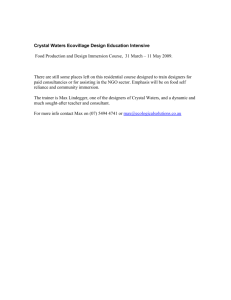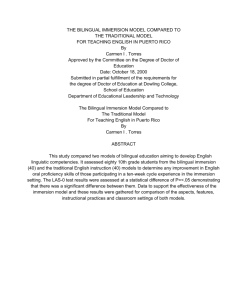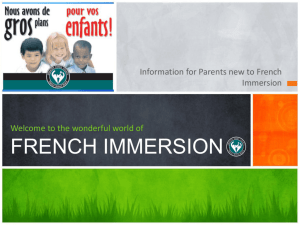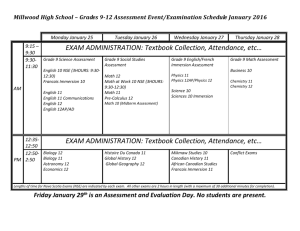Merging Virtual Learning Classroom Teaching and Immersion for
advertisement
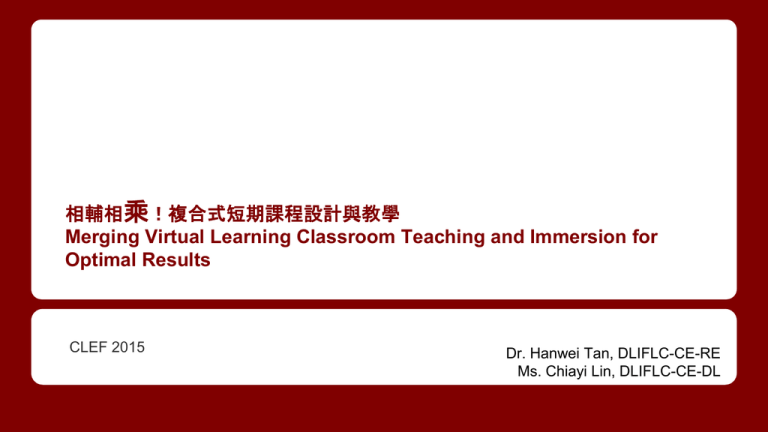
相輔相乘!複合式短期課程設計與教學 Merging Virtual Learning Classroom Teaching and Immersion for Optimal Results CLEF 2015 Dr. Hanwei Tan, DLIFLC-CE-RE Ms. Chiayi Lin, DLIFLC-CE-DL 複合式課程設計 Blended Curriculum Design ❖ Course structure: (3-in-1) OLL (refresher) + RE (level enhancement) + Immersion (authenticity) ❖ Learning Objectives:Post-basic students will achieve the 47 week intermediate course goals in 20 weeks. ❖ Design Concept:Promoting self-directed learning by scenario-based instruction ❖ Means and methods:student-content (SC) and studentteacher (ST) interaction in collaborative environments Blended Curriculum - Strength ❖ Course accessibility, flexibility and convenience increase learning opportunities ❖ Student autonomy, motivation, and readiness ❖ Promotes student-content (SC) and student-teacher (ST) interactions in collaborative environments ❖ Builds up students’ knowledge and proficiency incrementally ❖ Cost Merging Virtual Learning, Classroom Teaching, and Immersion for Optimal Results Pilot course (20 intensive weeks to achieve language enhancement). The course integrates three learning settings and interweaves four main threads: 1. Scenario/task-based Instruction 2. Semester Projects 3. Diagnostic Assessments and Backward Course Design 4. Evaluation/assessment Interrelationship between Teaching Settings RE Immersion RE OLL Scenario based instruction Semester projects Diagnostic assessments Evaluation/assessment Consistent , Correlative Collaborative (overlapping and promoting each other) Interrelationship between FLO Topic Connections: Integrative Spiral up Geography Science & Technology Culture & Society Level Enhancement Military & Society Politics & Economy Compressed into 20 wks from 47 wks Blended Curriculum Design FLO Topic Extension & Practice Presentation ODA OLL Project 1 Entry DA RE Integrates immersion lecture topics Assessments Immersion • Lecture • Excursion Assessments Presentation • Reflection Project 2 Pre- Immersion DA DLPT/OPI Preparation Project 3 Post Immersion DA OLL Daily Schedules (4 weeks) 2 hours OLL(DCO) 2 hours selfstudy(Sakai) Group class One on one • 2 hours OLL(DCO) • 2 hours selfstudy(Sakai) 2 hours OLL(DCO) 2 hours selfstudy(Sakai) Group class OLL Instruction Design Introduction Asynchronous Synchronous Initial Assignment Warm-up/ team building Content Modules Assignment (self-correction/Reflection) Review (Tasks/Feedback) Collaboration Tailored one-on-one sessions Conclusion Assessment Course Evaluation Review Summary Next steps Reference: http://www.learningsolutionsmag.com/articles/824/case-study-engaging-learners-in-the-synchronous-distanceenvironment OLL Platforms OLL: DCO LMS: Sakai Immersion Integrated RE curriculum FLO Topic Extension & Practice Presentation ODA OLL Project 1 Entry DA RE Integrates immersion lecture topics Assessments Immersion • Lecture • Excursion Assessments Presentation Goals • Reflection Project 2 Pre- Immersion DA Project 3 Post Immersion DA 4 Main Threads Interweaving the 3 settings 1. Scenario/task-based Instruction Daily/weekly culminating activities to enhance learning 2. Projects Driven Terms Integrating OLL, RE and Immersion FLO Topics 3. DA and Backward Course Design For self-directed learning/tailored instruction 4. Evaluation/assessment Scaffolding learning to higher levels 1. Scenario/task-based instruction: RE Weekly Schedule: 1 FLO Topic a Week Monday Tuesday Subtopic 1 Subtopic 2 Wednesday Subtopic 3 Thursday Subtopic 4 Friday Culminating Activity Recap Recap Recap Recap Consolidation Immersive Mode Learning Immersive Mode Learning Immersive Mode Learning Immersive Mode Learning Tests Daily Task Daily Task Daily Task Daily Task Scenario Presentation Non-Immersive Mode Non-Immersive Mode Non-Immersive Mode Non-Immersive Mode Scenario Topic related speaking/Writing Topic related speaking/Writing Topic related speaking/Writing Topic related speaking/Writing Topic Related Scholarly Hour Tailored HW Tailored HW Tailored HW Tailored HW Introduce Next week’s Topic RE Classroom Instructions Day 5 2nd weekly recap 3rd-4th culminating activity, debriefing and reflection Days 1-5, 1st hr: Introduce/Review & discuss prior day's topics Days 1-4, 2nd-4th hrs Topical R/L texts, analysis & tasks Daily & Weekly Schedule Days 1-4 Homework & preparation for culminating activity Days 1-4, 6th hour Mini-research, speaking tasks, topic expansion Days 1-4, 5th hour Non-immersive activities (review, grammar, translation, etc) 2. Projects Driven Terms Connecting learning settings/terms and promoting learner autonomy. Students are encouraged to select a project and develop, expand and deepen it through the whole learning process; that is, select a preliminary project during the OLL learning stage, develop it during the resident learning period, convert it to a higher level research paper in the university immersion phase. Each term, students are required to do a presentation to report their research and progress. This effort represents the students’ research and understanding. It is a measurable tool that helps students develop self-directed learning and brings them closer to their objectives. 3. DA and Backward Course Design ❖ Backward course design: final results and the course goal(s) ➢ What do I want my students to be able to think and do by the end of this course? ➢ How will my students be different by the end of the course? ❖ DA defines the floor, that is, where the student stands and where differentiated/tailored learning design and self-directed learning start. d Henry Personality Types : ESTP Learning Styles Auditory 32 Visual 24 Tactile 24 Kinesthetic 14 MSLQ IGO7 EGO 2 TV 6 CB5 SEL&P 5 TA2 E&L Impulsive 1Ramdom1 Global2 Inductive 2 2+/2/1+ 13/16 16/17/17 23/25/19 Brown Personality Types : ESTJ Learning Styles Visual 34 Tactile 34 Kinesthetic 28 Auditory 14 MSLQ IGO6 EGO6.5TV7CB6 SEL&P6.5TA 4.6 E&L Global 3 Sequential 7 2+/2/1+ 13/16 17/22/17 23/25/19 Tyler Personality Types : INTJ/INFJ Learning Styles Auditory 34 Kinesthetic 30 Visual 28 Tactile 28 MSLQ IGO 6.3 EGO4.5TV6.7CB4SEL&P5TA 7 E&L Global 1 Sequential 6 Deductive 6 2+/2/1+ 17/20 19/23/17 19/25/19 Diagnostic Analysis Track 4. Evaluation/Assessments ❖ Purpose: consolidating learning, and adjusting teaching and learning accordingly. ❖ Forms: ➢ Periodic tests (achievement and proficiency) ➢ Homework checks ➢ Rubrics (Presentation, Debate/projects/scenario) DLPT, OPI ➢ Sakai “Blog”, “One-on-one Note,” Peer review, learning logs, journal entries ➢ Recall protocol, Response, Learner Autonomy Discussion 1. Compressed schedule supported by effective design 2. Blended and collaborative learning 3. Promoting learner autonomy 4. Sustainment training 5. DA accuracy to guide learning and teaching QUESTIONS? Thank you!

